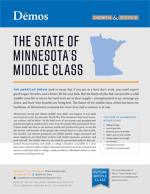The American Dream used to mean that if you put in a hard day’s work, you could expect good wages, benefits, and a better life for your kids. But the kinds of jobs that can provide a solid middle-class life in return for hard work are in short supply—unemployment is up, earnings are down, and hard-won benefits are being lost. The future of the middle class, which has been the backbone of Minnesota’s economy for more than half a century, is at risk.
Quick Facts from "The State of Minnesota's Middle Class":
- Although unemployment has been less severe in Minnesota than other parts of the country, the unemployment rate is at its highest since the early 1980s.
- Wages peaked at $39,312 in 2001 and have fallen 9 percent since to $35,700, leaving the typical worker at the same earnings level as 1999.
- The proportion of Minnesota workers who lack access to health insurance through an employer increased from 14 percent in 2000 to nearly 23 percent in 2010.
- Earnings for recent graduates peaked in Minnesota in 2002 and have plummeted since, declining 23 percent.
Minnesota’s strong and vibrant middle class didn’t just happen. It was built brick by brick in the decades after World War II by businesses that hired American workers and by labor—by the hard work of our parents and grandparents and the strength in numbers that came from the unions that represented them. Unions made sure that as our nation’s wealth and productivity grew, so too did the income and benefits of the people who worked hard to create that wealth. For decades, our nation’s prosperity was widely shared—wages increased and more employers provided their workers with health insurance, pensions, and paid time off. The middle class was also built by government policies that supported homeownership and made a college education accessible to a new generation. Parents without higher education themselves proudly scrimped and saved to send their kids to college, made possible by affordable tuition at state universities and financial aid.
But all of this is changing and Minnesota’s middle class is in jeopardy. Although Minnesota workers have fared favorably overall in terms of wages, benefits and employment levels compared to other states, many workers have seen their earnings stagnate or even decline over the last 30 years. There’s also been a rapid decline in the number of employers who provide their workers with health insurance. Rising out-of-pocket costs and skimpy plans mean that a family illness can lead to substantial costs and medical debt. And as employers replace traditional pensions with 401(k)-type plans, middle-class workers can no longer count on a secure retirement.
Several factors threaten the future of Minnesota’s middle class. Manufacturing jobs, which tend to be unionized and offer better pay and benefits, took a dive in the early 1990s but made an impressive recovery in the latter part of the decade. Yet since 2000, Minnesota’s manufacturing sector has sustained devastating declines. Job growth has predominated in the service sector, where unions are less prevalent, pay is lower, and employers are less likely to offer health and retirement benefits.
At the same time, it has become more costly to raise a family. Several decades ago, most middle-class mothers were not in the paid labor force. But now that a majority of mothers are employed, families must pay for child care. High-quality care for preschoolers is expensive, yet parents face these costs early in their working years when their earnings are low. Housing is also more expensive relative to household income than it was decades ago. The need for most working parents to have their own vehicle and the high price of gas further strain middle-class family budgets.
The threat to the future of Minnesota’s middle class can be seen most clearly in the economic prospects for the state’s young people. Today, the majority of young workers are earning less than their mothers and fathers did a generation ago, with substantial declines among men. Skyrocketing college costs are making it hard for all but the most affluent students to stay in school and graduate. College graduates in Minnesota have some of the highest levels of student debt in the nation, but their earnings have dropped precipitously over the last decade. Young workers are increasingly less likely to have access to health insurance and retirement benefits through their employers, with the most dramatic changes occurring in recent years.
The unraveling of the social contract predated the Great Recession, but the economic crisis hastened its demise. Not only did the state lose over 110,000 jobs because of the Wall Street-caused Great Recession, but the economic effects of those lost jobs reverberated to all corners of the state, particularly the already-strained finances of the state government. We estimate that the jobs lost due to the recession have cost the state nearly $300 million dollars in lost tax revenues, putting thousands of middle-class jobs at risk. If the state’s unemployment rate were at pre-recession levels, those lost hundreds of millions would return to the state government’s coffers, and could be used to help thousands of young people attend college, maintain dozens of state parks, or hire, for example, as many as 3,900 teachers or 2,700 nurses.
Now is the time for employers, workers, and policymakers to come together once again to rebuild pathways to the middle class, create good jobs with fair pay and decent benefits, and ensure that prosperity is broadly shared for the next generation.
